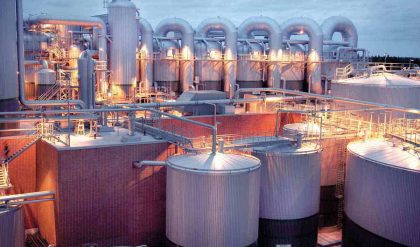The Heat of Reaction (also known and Enthalpy of Reaction) is the change in the enthalpy of a chemical reaction that occurs at a constant pressure. It is a thermodynamic unit of measurement useful for calculating the amount of energy per mole either released or produced in a reaction. Since enthalpy is derived from pressure, volume, and internal energy, all of which are state functions, enthalpy is also a state function.
Introduction
ΔHΔH, or the change in enthalpy arose as a unit of measurement meant to calculate the change in energy of a system when it became too difficult to find the ΔU, or change in the internal energy of a system, by simultaneously measure the amount of heat and work exchanged. Given a constant pressure, the change in enthalpy can be measured as
ΔH=q(1)(1)ΔH=q (1)
See section on enthalpy for a more detailed explanation.
The notation ΔHº or ΔHºrxn then arises to explain the precise temperature and pressure of the heat of reaction ΔH. The standard enthalpy of reaction is symbolized by ΔHº or ΔHºrxn and can take on both positive and negative values. The units for ΔHº are kiloJoules per mole, or kj/mol.
ΔH and ΔHºrxn
· Δ = represents the change in the enthalpy; (ΔHproducts -ΔHreactants)
o a positive value indicates the products have greater enthalpy, or that it is an endothermic reaction (heat is required)
o a negative value indicates the reactants have greater enthalpy, or that it is an exothermic reaction (heat is produced)
· º = signifies that the reaction is a standard enthalpy change, and occurs at a preset pressure/temperature
· rxn = denotes that this change is the enthalpy of reaction
The Standard State: The standard state of a solid or liquid is the pure substance at a pressure of 1 bar ( 105 Pa) and at a relevant temperature.
The ΔHºrxn is the standard heat of reaction or standard enthalpy of a reaction, and like ΔH also measures the enthalpy of a reaction. However, ΔHºrxn takes place under “standard” conditions, meaning that the reaction takes place at 25º C and 1 atm. The benefit of a measuring ΔH under standard conditions lies in the ability to relate one value of ΔHº to another, since they occur under the same conditions.
How to Calculate ΔH Experimentally
Enthalpy can be measured experimentally through the use of a calorimeter. A calorimeter is an isolated system which has a constant pressure, so ΔH=q=cpsp x m x (ΔT)

How to calculate ΔH Numerically
To calculate the standard enthalpy of reaction the standard enthalpy of formation must be utilized. Another, more detailed, form of the standard enthalpy of reaction includes the use of the standard enthalpy of formation ΔHºf:


